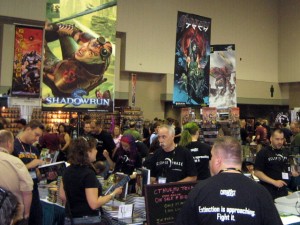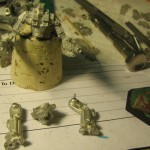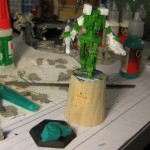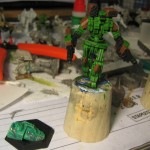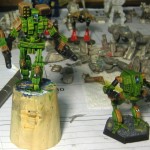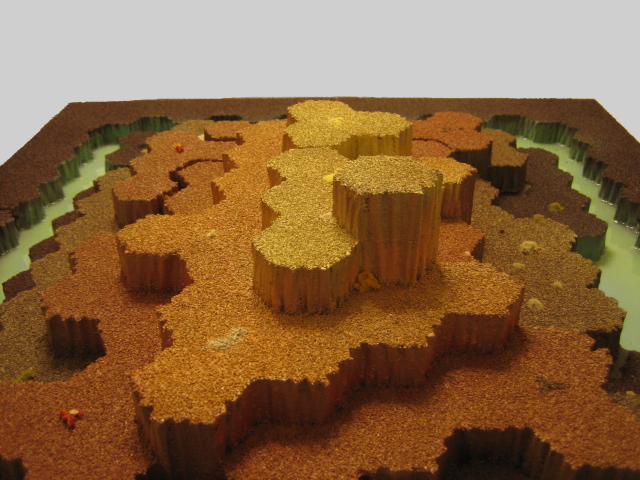
Hex maps in 3D provide the best of both worlds. The attractive looks of 3D terrain meets the simplicity of map sheet rules. I always have fun building maps with my good friend and fellow contributor Saxywolf. Last weekend we had a go at building an iconic map from the Solaris 7 MapPack.
King of the Mountain is a map that just screams to be in 3D. It was a pleasure to build and I just love the results. Read on to see how all the bits of foam came together as we built this great looking map.
Materials List
- Pink insulation foam
- Hex paper and pins
- Hot wire foam cutter
- Apple Barrel Paints (Brown and Black)
- Paint brushes
- Elmers glue
- Woodland Scenics Medium Ballast
- Poster board (40 x 30)
- Various shades of spray paint
- Woodland Scenics Realistic Water
- Miscellaneous ground cover (static grass, flock, rock debris, foliage)
Planning the Map
We made ample use of paper templates to help us mark what we needed to cut. Each level is it’s own cut of foam, so getting them right was important to keep the map accurate.
We chose to use 2″ hexes for our map to give our miniatures a little extra breathing room on the battlefield.
Here at the ScrapYard we use large format paper printouts to make cut-outs for the large level 0, level 1, and level 2 terrain. If you don’t have such a luxury don’t fret. Standard 8 1/2 x 11 sheets work just as well with a little patience and a lot of scotch tape.
Once you have your paper templates ready, use a few pins to attach them to your foam.
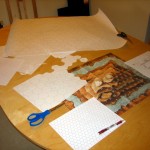
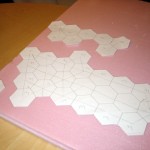
Cutting the Foam
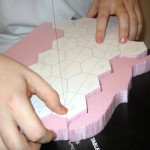 You are going to need a Hot Foam Cutter of some kind for this task. You can get one from any respectable model railroad store. We made use of a system from Hot Wire Foam Factory and it worked great. Whatever tool you end up using, make sure you use as thin a wire as you can get away with. The thinner the wire, the less stringy strands will result from your cuts making them faster and more accurate.
You are going to need a Hot Foam Cutter of some kind for this task. You can get one from any respectable model railroad store. We made use of a system from Hot Wire Foam Factory and it worked great. Whatever tool you end up using, make sure you use as thin a wire as you can get away with. The thinner the wire, the less stringy strands will result from your cuts making them faster and more accurate.
Use your templates as a guide and cut out all of your levels. Depending on how many levels and the complexity of the shapes you are making, this may take a while. If it was easy, it wouldn’t be nearly as cool.
Shaping the Foam
Shaping the edge of your foam will give it an authentic look. We don’t see ninety degree angle cliff faces in nature and your hills shouldn’t either.
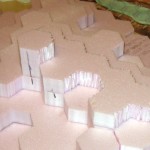 First things first, lay out your levels on top of each other as they will fit when they are attached. Look at the level changes and mark those that are more than one level high. You are going to shape the single elevation edges first. Once you have multiple levels glued together you will then shape the two and three level change faces. See the picture for a sample of what I’m talking about.
First things first, lay out your levels on top of each other as they will fit when they are attached. Look at the level changes and mark those that are more than one level high. You are going to shape the single elevation edges first. Once you have multiple levels glued together you will then shape the two and three level change faces. See the picture for a sample of what I’m talking about.
Use your hot foam tool of choice and work across the surface with a wavy pattern. Use a piece of scrap foam before you start on the real thing if you are unsure of the technique. Once you do it yourself and see the results, it will become obvious how to get a simple yet effective result. After only a few edges you will be a pro.
As we shaped the foam we glued levels together. Once the glue had a chance to set we shaped the two and three level cliff faces. At this point though, we did NOT glue the level 0 terrain to the rest. It was kept separate for reasons described below. Keep on reading!
Base Coating
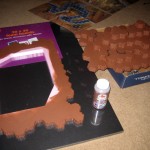 Base coating provides your terrain protection from the spray paint you are going to apply later. We use Apple Barrel paint because it is cheap and easy to work with Acrylic based paint. It covers well and seals the foam so we can apply spray paint later on.
Base coating provides your terrain protection from the spray paint you are going to apply later. We use Apple Barrel paint because it is cheap and easy to work with Acrylic based paint. It covers well and seals the foam so we can apply spray paint later on.
Wait for this base coat to dry for a few hours and go over it again to make sure you have hit all of the nooks and crannies. Depending on how detailed your edges are you are going to want to make sure the whole piece is covered.
Putting It All Together
Our base is a large (40″ x 30″) poster board we got at Staples. We glued only the level 0 terrain to the board.
One of the issues that we have found on previous maps was warping of the poster board over time. When you are gluing two different materials together like we are, you are bound to notice a bow or sag to your map as the poster board flexes under your foam. This is unavoidable unfortunately. We have thought of some methods to stiffen up the construction but all of them would inevitably lead to a heavier and bulkier map. One of the major advantages of using foam and poster board is how light and transportable they are.
As a mitigation we glue only the first level of terrain to the board. Anything level one and above gets glued together but not to the level 0 you glued to the poster board. What you end up with is a board with removable terrain features. Not only does this result in less warping but also make the board much easier to transport and store.
Adding Some Texture
Break out the Elmers and make sure you have a lot of it to spare.
In order to make our map look as good as it can we base the top part of our foam with a medium railroad ballast to give it a proper texture. Using a foam brush we spread a healthy amount of Elmers glue onto our terrain. Once the glue is down we sprinkle liberally with our gravel texture.
After all of your terrain is covered, give the last layer about five minutes before flipping it upside down to get off the gravel that didn’t stick. I hope you have some sort of large paper underneath to catch the excess. We dumped it on the poster board, brushed it onto a piece of paper and poured it back into the container. You will be using less gravel than you think. Make sure you don’t waste what comes off during this step.
Make sure you give this step as much time to dry as you can. Excess glue can leach into the base coat of paint making your foam potentially vulnerable to spray paints until the whole thing has time to dry and set completely.
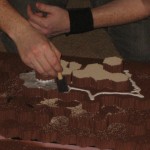
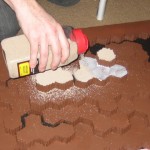
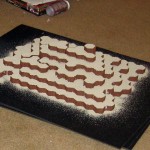
Painting
We took all of our terrain outdoors for a whole lot of spray paint.
There certainly is an art to doing this well. I have to give all of the props to Saxywolf for an amazing job choosing colors and blending them together just right to give us the colors you see on the final map. He made clever use of some of the leftover paper templates to cover up portions of the map when applying the last colors on the acid moat and then touching up the brown by covering the acid moat. If you can wait for a day with no wind, you will not have to keep re-spraying to touch areas up. To blend the the entire map together a bit more, he used a mid-tone color from farther away.
Take your time and you’ll do fine. If you happen to feel overwhelmed, use another piece of scrap foam (properly base coated with Apple Barrel paint) to try out some of the colors you intend to use.
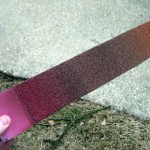
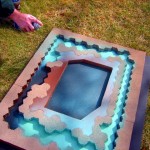
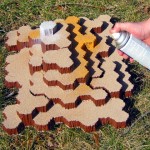
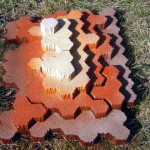
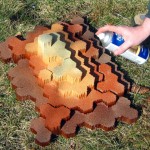
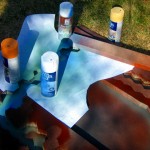
Water Effects
To add a little extra to the acid moat we used a pourable realistic water effect from Woodland Scenics. Even after drying overnight the water wasn’t completely cured. Keep this in mind as you plan as the stuff becomes very tacky and will catch anything that gets near including flock and static grass that you may want to add in the last steps. I’d advise you cover it very well and give it extra time to dry.
Adding the Details
Hex delineation is important for these 3D maps. We are still relying on hexes for range and line of sight after all. In previous maps we used a sharpie to put a dot where individual hexes were not easily seen. For King of the Mountain we tried something a little different. We used little bits of terrain, rocks, static grass, and foliage to mark the hexes providing character and functionality in one swing.
Here are a few shots of the finished product. We managed to build this map start to finish in one weekend. Between each step that required substantial dry time we played a few games of Battletech. Nothing like smashing ‘Mechs while you wait for the Elmers to dry. If you look closely you can see the dark brown base remains unattached to the mountain in the middle.
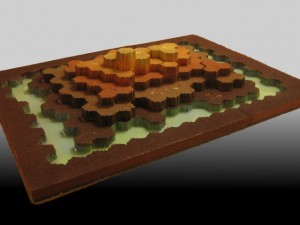
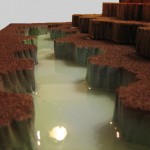
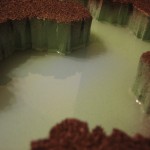
Posted under
Terrain
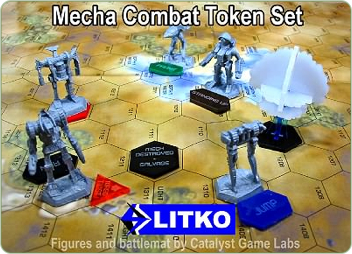
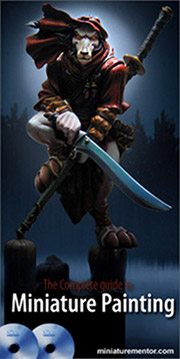






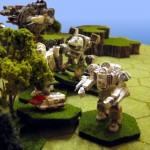
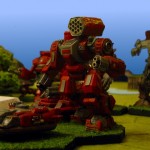
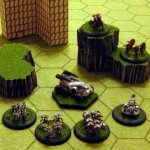
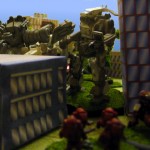
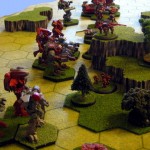
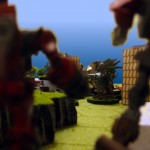


















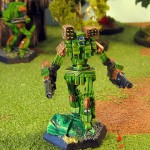 My
My 






